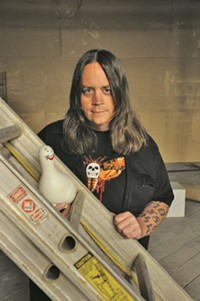I laughed when I approached the first tee at Holladay’s Creekside Park five years ago. This guy stood on the tee pad stretching—stretching!—before he teed off. It’s Frisbee golf, man. If you need to stretch first, you’re one delicate little daisy.
Then, in a demonstration of ballet-like grace, he took three steps and threw. The disc shot from his hand with a loud snap. Unlike a gracefully floating traditional “toss” Frisbee, his flatter, more streamlined platter held a long line drive for more than 300 feet. Finally, it dove left, landing five feet from the target, a metal basket draped with 24 chains. (No, those chain targets aren’t park decorations or grills, as some uninitiated folks have surmised.)
When a disc hits the chains, it makes a sound disc golfers love: ching! It’s musical. Hit a floating putt and it’s like wind chimes. Hit an upshot, and it’s like a cymbal crash. Nail a hole-in-one—or “ace”—and the ching is accompanied by a chorus of hoots and hollers from the other players.
“Watching a disc fly is fascinating,” says disc golfer and wildlife biologist Markus Mika. Discs can fly straight, take towering hyzer (left-banking) or anyhyzer (right-banking) lines, or weave in and out of trees in sublime, swooping s-curves. It’s “spellbinding,” he says.
Creekside’s course is actually called the Walter Frederick Morrison Disc Golf Course, in honor of the Utahn who invented the flying disc. But “this ain’t your daddy’s Wham-O,” says avid disc golfer Richard Saunders.
It’s true. Disc golf entails a lot of technique and even a rudimentary understanding of flight physics. Stretching helps prevent back injuries or dislocated shoulders. As with the PGA in ball golf, the Professional Disc Golf Association (PDGA) governs and promotes the sport. There are star players, like 12-time PDGA World Championship winner Ken Climo and currently No. 1-ranked player Paul McBeth. Disc golf equipment and clothing companies are proliferating in the United States as well as internationally.
The popularity of disc golf is growing rapidly in Utah as well. “Five years ago, we stocked about 300 discs.” says Trone Throndsen of Play It Again Sports in Sugar House, the state’s largest disc-golf retailer. He gestures toward a 15-foot section of the store’s north wall—and an adjacent two-sided, 5-foot tall, 4-foot wide shelf. “Now we have over 3,000 discs for sale.” The variety of discs is astounding: drivers, mids and putters from two dozen manufacturers. Drivers have tapered rims to cut the wind, and fly 70 to 80 mph. Midrange discs are wider, with more glide. Putters have blunt rims for shorter, more precise flights.
Disc golf clubs like Team Utah Disc Golf, SLC Tunnel Runners and Utah Disc Chics raise money to maintain courses. Currently, the disc-golf social-networking site DiscGolfScene.com lists 47 courses in the state. Most—like Creekside (co-designed by “Steady” Ed Headrick, the “father of disc golf,” who also designed the chain targets), Riverdale’s Riverside Park and the Art Dye Disc Golf Park in American Fork—are free to play. Some, like the gorgeous, challenging course at Solitude Mountain Resort, require a $10 lift ticket (but you can hike up for free). “Soli,” as local disc golfers call it, also hosts the annual Monster Energy Challenge, a PDGA A-tier tournament that attracts many traveling pros.
“Utah has some of the most extreme landscapes, which provide some of the most extreme disc golf courses,” says Dave Roper, PDGA Utah coordinator and Monster Energy Challenge tournament director. Solitude, Snowbasin, The Canyons and Brian Head ski resorts all open their disc golf courses during the summer. There are also two courses in Moab and a desert course in Torrey, with an inn/pizza parlor/brewpub on the first tee.
What every disc golfer values as much as the game, however, is the strong sense of community. Disc golf is a universal sport played by men, women and children of all ages and levels of athleticism. “We are doctors, lawyers, teachers, businessmen and even politicians,” says Zack Ralphs, tournament director for the Creekside Open pro weekend. “In fact, last year’s Masters champ is a pharmacist here in Salt Lake City.”
Most experienced disc golfers welcome and help new players. But the prevailing ethos is that technique will come—just have fun, enjoy the environment and the company. “The people are the least judgmental folks I’ve dealt with in a sport or hobby,” Mika says.
“We look out for each other,” Ralphs says. “I wouldn’t be the man I am today without [my mentors] and this game. I love it more than anything else.”
Ralphs also oversees the weekly Tuesday night doubles tournament. As four dozen players gather for post-tourney payouts, Ralphs checks our priorities—namely, whether we’ll help spruce up the park for the annual Creekside Open, which finishes up May 3 and 4. “This is our disc golf park,” Ralphs bellows to the crowd of players who braved the wind, dust and rain. “It’s our home. Let’s take care of it.”Â
More by Randy Harward
-
Live Music Picks: April 19-25
MC Chris, Talia Keys & the Love, Nick Passey, Brian Wilson and more.
- Apr 18, 2018
-
Live Music Picks: April 12-18
Judas Priest, The Residents, Clownvis Presley, The Breeders and more.
- Apr 11, 2018
-
Rock-It Fuel
Local musicians dish on the grub that puts the bomp in their bomp-bah-bomp-bah-bomp.
- Apr 11, 2018
- More »




